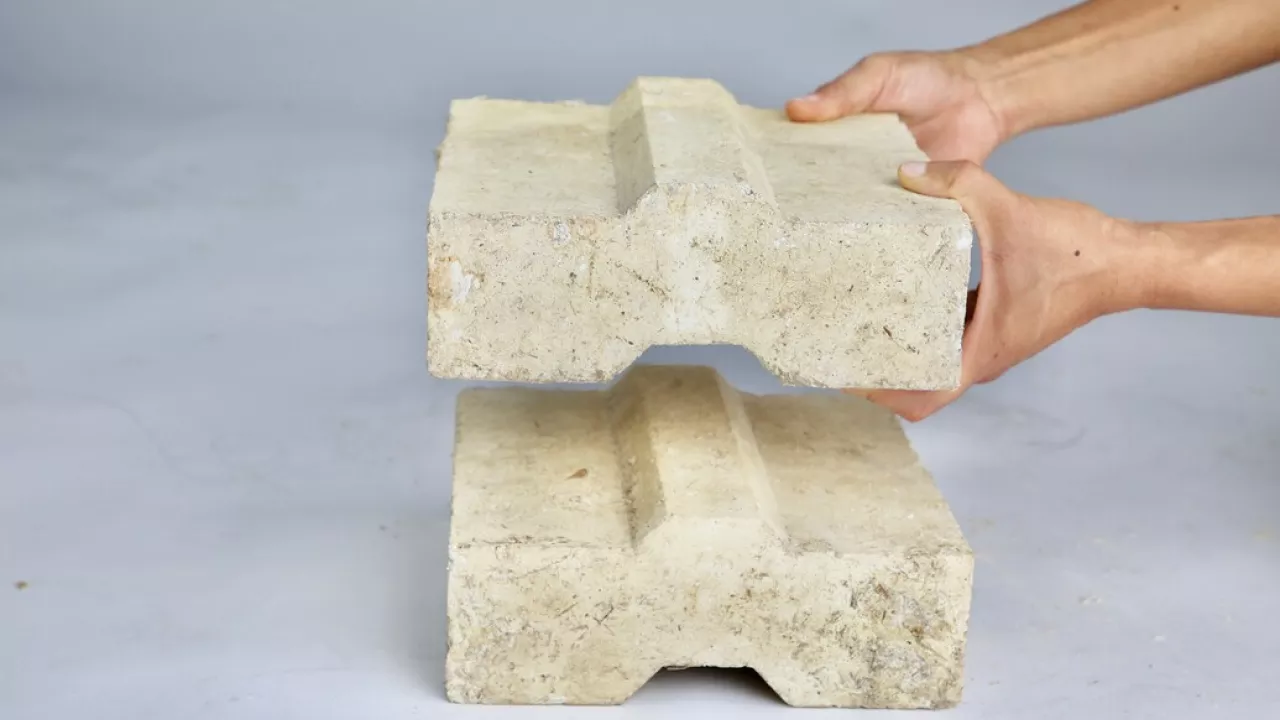Sugarcrete
Sugarcrete
About Sugarcrete®️
Sugarcrete® provides a low-carbon alternative to bricks and concrete blockwork developed by the University of East London (UEL). The material combines sugarcane fibres left over after sugar production, with sand-mineral binders to produce bricks that have a carbon footprint six times smaller than traditionally made clay bricks.
This low-carbon material is just a part of the project's ambitions. The project seeks to offer different viable, sustainable, and safe construction solutions, using bio-waste as the core resource, to enhance community wellbeing and security.
The project has been developed as a collaboration between the UEL MArch Architecture programme and the Sustainability Research Institute (SRI) with the support of Tate & Lyle Sugars.
Project details
The aim of the project is to develop ultra-low carbon building components using sugarcane bio-waste (bagasse), allowing the storage of biogenic carbon from fast-growing plants in construction materials as an effective strategy to delay carbon emissions.
Sugarcane is the world's largest crop by production volume. The processing of sugarcane to produce sugar generates enough raw material to partially replace high energy-demanding construction systems such as concrete or brick. Sugarcane growth provides one of the fastest CO2-to-biomass conversion mediums available, up to 50 times more efficient than forestry.
Research developed at UEL demonstrates how this residue stream can provide a sustainable construction material. The new Sugarcrete®️ material, prototyped using the Sustainability Research Institute’s advanced laboratory, presents high-quality mechanical, acoustic, fire and thermal properties, and has been tested to industry standards for fire resistance (ISO 1716:2021), compressive strength (ASTM C39), thermal conductivity (Hot-Box method) and durability (BS EN 927-6). The testing has shown promising results for Sugarcrete®️ to be used as insulation panels, lightweight blocks, load-bearing blockwork and structural floor and roof slabs.
Sugarcrete® research will benefit local manufacturers in the global south where construction materials are frequently imported, environmentally poor performing, high cost and high carbon minimises transportation costs. Local producers can make radically new, affordable and ultra-low carbon ‘vernacular’ building materials that can create new income streams via export to the global North.
As such, Sugarcrete® is not patented. It is purposely ‘open access’ in order to establish partnerships to produce new bio-waste-based construction materials where sugar cane is grown, and the benefit is greatest.
Sugarcane waste to be used as low carbon alternative to concrete
View the project in action
Project updates
- Sugarcrete® visit in India: the production facilities of Sugarcrete® in India and a presentation to students at the School of Planning and Architecture in Delhi
- Sugarcrete® database: a platform with different Sugarcrete® formulas pre-tested and approved for builders
- Over the tracks project: Sugarcrete was used to build a community garden in North Woolwich
- Sugarcrete®️ Slab: a demountable, reusable, fire-resistant composite floor slab in collaboration with Grimshaw
Team
Sugarcrete® Project Lead
- Armor Gutierrez Rivas, UEL Senior Lecturer in Architecture
- Alan Chandler, UEL SRI Co-Director
- Bamdad Ayati, UEL SRI Senior Research Fellow
Sugarcrete® Project Collaborators
- Oluchukwu Okonkwo, Sugarcrete PhD student and researcher
- John Kerr, Vice President, Research & Technology, Tate & Lyle Sugars
- Nicolo Bencini - Senior Structural Engineer, AKTII
- Paul Nichols – UEL FabLab Manager
Sugarcrete® Slab Collaborators
- Elena Shilova, Grimshaw
- Paris Nikitidis - XR Developer, Grimshaw
- Philip Singer - Computational Design Specialist, Grimshaw
- Robert Sims - Model shop Manager, Grimshaw
- Sky Henley - Computational Design Specialist
- Louis Bird, Video editing and filming, Grimshaw
- Ellie Saunders, Video editing and filming, Grimshaw
UEL Master of Architecture Students Team:
Faith Omowunmi Ogundare, Busra Ciftci, Amy Gillespie, Hinal Arvindkumar Patel, Rova Taha, Dodangodagamage Kawan Roger Ranasinghe, Manoj Sai Ganji, Mohan Ukabhai Dungrani, Anca-Madalina Borda, Alina Klimenteva, Rashmi Madagamage Gunathilaka, Orseer Isreal Gbashah, Mahmoud Sayed Abdellattif, Mert Manas Erten, Hidayati Yazmin Binti Abdul Halim, Oluchukwu Judith Obiejesi, Svetoslav Georgie Slav, Mihriban Ustun, Sinan Aldulaymi, Francesco Stefan, Cristian Severin, Shushant Jadhav, Twinkle Shah, Jason Tshibangu, Dhanuj Basavenahlli Govinda Gowda, Megan Jones, Alina Obreja, Gideon Olufemi Oluwole-Wise, Nauma Patel, Hinal Arvindkumar Patel, Nishant Bharatbhai Thakkar, Sharanya Rajashekhar, Elsa Lea Sebille, Sumaya Sheikh-Ali, Joshua Vediena.
Photography
Chromaphotography
Videography
Jude Adoasi
Award nominations
- Built by Nature Prize 2024: phase 2
- Earthshot Prize: Longlisted under the category of building a waste-free world 2024
- Climate Positive Awards Green Cross UK: Winner 2023
- Earthshot Prize: Longlisted under the category of building a waste-free world 2023
- Dezeen Sustainability Award – Material Innovation Category: Shortlisted 2023
- RISE Award Leeds Becket University: Finalist 2023
Sugarcrete® in the news
- Sugarcrete® feature in Sustainable Science “What’s next?” programme for Irish State Broadcaster - Hopskip Studios, March 2024
- Researchers transform sugarcane by-product into slabs and bricks – New Civil Engineer, March 2024
- NBS feature filmed at the SRI Laboratory - Universal, January 2024
- In its own sweet time: sustainability and innovation - Forbes South Africa, December 2023
- Sugacrete selected as one of the 9 best green innovations of 2023 by edie - Edie, January 2024
- Award triumph for UEL project at COP28 - UEL, December 2023
- Community garden to get Sugarcrete®️ makeover - UEL, December 2023
- Sugarcrete®, a revolutionary building material made from sugar cane – Franceinfo, October 2023
- Sugarcrete® - JT Soir Guad, October 2023
- Green award nomination for UEL project - UEL, October 2023
- Taste of sugar for building fair - UEL, September 2023
- Sweet taste of success - UEL, September 2023
- Grimshaw and UEL develop Sugarcrete blocks that "could replace the traditional brick industry" - Dezeen, May 2023.
Technical reports
UEL Sugarcrete Report Oct 2021
pdf, 8.9 MB
UEL Sugarcrete Slab Report - 7 Nov 2022
pdf, 9.14 MB














